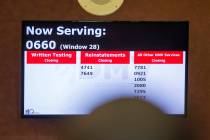EDITORIAL: Community college grant program misses mission
Before throwing money at any problem, it’s always best to identify that problem as precisely as possible, and understand that different circumstances may call for different solutions. That’s something state legislators and the Nevada System of Higher Education learned last month.
As reported by the Review-Journal’s Ana Ley, the newly created Silver State Opportunity Grant, designed to help Nevada’s poorest students pay for higher education, had disappointing results at the College of Southern Nevada. About 45 percent of CSN students who received the grant during the fall 2015 semester failed to meet a course-load requirement, and therefore lost the award for the remainder of the academic year.
The grant program, established through the passage of Senate Bill 227 in the 2015 Legislature, allocated $5 million to degree-seeking Nevadans enrolled in a community college or Nevada State College. But students who received the grant — based on need through personal income, family income and federal aid — needed to fulfill the program’s 15-credit-per-semester requirement. Of CSN’s 394 recipients, 178 couldn’t meet that mandate, more than half of whom were minority students. The other five schools in the program had at least 71 percent of recipients meet the requirement.
“The CSN number is disappointing,” said Crystal Abba, who oversees the grant for the Nevada System of Higher Education. “We clearly need to work more closely with CSN students to ensure their success.”
Here’s a good place to start: Not promoting a one-size-fits-all program, and also understanding what community college is, and what it isn’t. To the first point, CSN, with its multiple large campuses across a huge metropolitan area with a diverse population, is not the same as Great Basin College, whose campuses are in more remote communities. Thirty of Great Basin’s 37 grant recipients met the course-load requirement (81 percent). And CSN is not the same as Nevada State College, a four-year public college where 82 of 97 recipients fulfilled the requirement (84 percent).
To the second point, the idea that you have to be a full-time student to qualify for community college aid, especially given today’s economy, is a broken one. Community colleges are places where people who lack work skills go to gain that experience, or where people go if they need job retraining or to collect core requirements toward a four-year degree. Community college attendees often log many hours a week at full- or part-time jobs, more so than traditional college students, so they might only take one or two classes at a time. At CSN, only 5.6 percent of the more than 34,000 students are enrolled in 15 hours or more per semester; 73.6 percent — 25,353 students — are enrolled in less than 12 hours per semester.
If the Legislature and NSHE are serious about helping poor students pay for higher education, then they should take into account the differences between community colleges, and the mission of community colleges. Then they should consider creating a program that actually helps part-time students.

















